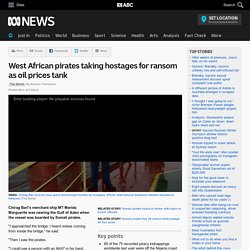

West African pirates taking hostages for ransom as oil prices tank. Posted Chirag Bari's merchant ship MT Marida Marguerite was nearing the Gulf of Aden when the vessel was boarded by Somali pirates.

Key points: 65 of the 75 recorded piracy kidnappings worldwide last year were off the Nigeria coastThe spike in kidnappings is a recent trend due to a downturn in oil pricesThere have been groups with political agendas, but most pirates are criminals motivated by money. BY: JACK, ALLEN, RYAN, AND JOSH - Home. Poaching WebQuest. Home. Sign in - Google Accounts. One account.

All of Google. Sign in with your Google Account Find my account Forgot password? Sign in with a different account Create account One Google Account for everything Google. STOP POACHING - Home. Mysite. Framing Organizer. About - Bring Back Our Girls. Escape From Boko Haram. Shortly before six o’clock in the morning on August 30, 2014, Margee Ensign, president of the American University of Nigeria, met with her security chief in the large house that she occupies on campus, in Yola, near the nation’s eastern border, in Adamawa State.

The news was bad. The chief, Lionel Rawlins, had gone to get the half-dozen security guards that Ensign was counting on to help her with a daring rescue mission, but the guards were asleep, or perhaps pretending to be, and couldn’t, or wouldn’t, be roused. “They were afraid,” Rawlins later recalled. Running a college doesn’t often entail making split-second decisions about daredevil forays into hostile territory, but as this Saturday dawned for the energetic five-foot California native with a doctorate in international political economy, it was gut-check time.
“The president looked at me and I looked at her, and I knew what she was thinking,” Rawlins said. “We’re going,” Ensign said. Rawlins, a former U.S. Trained to Kill: How Four Boy Soldiers Survived Boko Haram. Boko Haram. 10 Boko Haram Facts - WMNews Ep. 11. Boko Haram and the crisis in Nigeria, explained. FACTSHEET: Explaining Nigeria’s Boko Haram & its violent insurgency.
Boko Haram Storms Girls’ School in Nigeria, Renewing Fears. DAKAR, Senegal — Islamist militants stormed into a girls’ school in northern Nigeria this week, and with many girls still unaccounted for, Nigerians feared their country was experiencing a notorious mass abduction like one that drew worldwide condemnation almost four years ago. Is Africa facing a new wave of piracy? Image copyright Getty Images The recent hijacking of a ship by Somali pirates was the first such incident off the Horn of Africa since 2012, and more ships are being targeted off West Africa.

But why are attacks increasing and how should the international community respond? The latest State of Maritime Piracy report by the watchdog Oceans Beyond Piracy (OBP) warns against security complacency in the shipping industry, particularly around the Horn of Africa. It appears the industry has gone from a state of heightened security awareness to taking its foot off the pedal.
Economist. This Is the New Piracy Hot Spot. It’s Tuesday morning, and Phillip Belcher pauses anxiously before opening an email.

The subject line reads: “Vessel under attack at this moment.” He clicks through to the bleak description that notes a ship is under attack by a skiff, or small boat — and under fire. “Nobody attempted to board vessel yet,” the message continues, “but the crew is afraid that it may happen.” From Belcher’s office in central London, there is little he can do for those seamen besides hope for the best. As marine director of the International Association of Independent Tanker Owners, which represents oil tankers from 40 countries, Belcher is getting used to receiving alerts about ongoing pirate attacks. Over the past decade, most talk of piracy seemed to lead back to East Africa. The Rescue of Jessica Buchanan.
The Real Maersk Alabama/Somali Pirate story (Never seen before footage) Captain Phillips - Official Trailer #2 - In Theaters 10/11. Episode 1: The Plight of the Elephant. The Race to Stop Africa’s Elephant Poachers. The call came in to Gary Roberts last March at his home in Béré, a village of subsistence farmers deep in the sorghum and cotton fields of southern Chad.

Reports were circulating, a local conservationist told him, that a mass killing of elephants had occurred some 100 miles away, near the Cameroon border: Could Roberts see what he could find out? Roberts, 36, a Seventh-day Adventist missionary, experienced bush pilot and amateur conservationist who sometimes flies research missions for Chad’s wildlife department, climbed into his single-engine, four-seat Cessna. He took off from the mission’s dirt airstrip and headed north toward the border. Roberts cruised for three hours over a vast green carpet—low-lying brush, sorghum fields and stands of acacias, broken by an occasional dirt road or cattle trail. Roberts counted the skeletons of between 15 and 20 elephants. Now the Sahel has again become a killing ground. Error loading player: No playable sources found. Iworry. Kenya Sends Ivory Poachers A 105-Ton, Burning Message. Ivory Wars Upfront. A brief history of the ivory trade. ‘I liked elephant heart. It was soft and very tasty’
I was born in Kinigi, in Rwanda’s Musanze district, about 65 years ago, and it is still my home.

I come from the Batwa community; we are very short people. There are about 400 of us, which makes us the smallest tribe in Rwanda. We lived in the forests long before the government took them over, and we were known as their keepers. They meant everything to us. I did not even know what a school was. For many years we depended on bush meat to feed ourselves. Documentary. The Dark Side Of Chocolate. Chocolate The Bitter Truth 1 of 5 Child Trafficking BBC Panorama Investigation. Stop Child Labor – Sign the Pledge! Slavefreechocolate. Inside Big Chocolate's Child Labor Problem. By Brian O'Keefe Photographs by Benjamin Lowy For a decade and a half, the big chocolate makers have promised to end child labor in their industry—and have spent tens of millions of dollars in the effort.

But as of the latest estimate, 2.1 million West African children still do the dangerous and physically taxing work of harvesting cocoa. What will it take to fix the problem? The boy with the machete is watching us. We scramble out to greet him. Child Labor and Slavery in the Chocolate Industry. Cocoa-nomics: Child labor in the cocoa industry. International Labor Rights Forum. More than 70% of the world’s supply of cocoa comes from two countries nestled on the southern shore of West Africa: Cote d’Ivoire and Ghana.

There, whole communities are dedicated to growing the crop that is lucrative for governments and international traders, but brings below-poverty wages for the farmers who produce it. Low wages mean farmers cannot hire the labor needed to harvest the crop, and perpetuates the child trafficking and worst forms of child labor that have plagued the industry. Children are exposed to chemicals, long working hours, and the denial of a decent education.